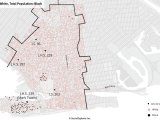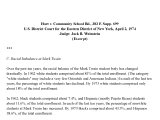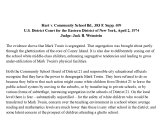You are here:
School Zones
Do school enrollments match the neighborhoods or areas where schools are located? That is, does the school’s student population, in terms of race, language, ability, class, or other factors, look similar to that of the surrounding area? Why or why not?
Read More
In 1973, Coney Island was part of Brooklyn’s Community School District 21, one of the 32 districts that the city school system was divided into at the time. Nearly 70 percent of the district’s students were white. But at Mark Twain Junior High School in Coney Island, the student population was 81.9 percent “nonwhite” – mostly Black and Puerto Rican students.1
How did that come to be? Doris Hart, mother of Mark Twain student Jeffery Hart, went to court with her attorneys in 1972 to argue that New York’s schools were segregated by race, and that school district decisions, especially about school zoning, were responsible. School zoning decided which students, coming from which neighborhoods, would attend which school. Other Black parent activists had been pushing the district to change Mark Twain’s zoning for over two years before Hart filed her suit.2
Hart v. Community School Board 21 was a class-action lawsuit on behalf of Black children attending Mark Twain Junior High School. It was the first school desegregation case in New York City to reach a federal court.
In January 1974, the United States District Court of the Eastern District of New York issued its ruling in Hart.3 Judge Weinstein found that housing segregation led to school segregation, but also that the school district’s decisions about school zones made segregation worse. Zones were the geographical areas where students who attended a given school lived. Zones were lines on a map that the school district had the power to change if it wanted. The district could draw zone lines that included white, Black, and Puerto Rican neighborhoods, for example.
Judge Weinstein ordered that the district change its school zones, cooperate with housing officials, and otherwise work to achieve a larger white enrollment at Mark Twain. But he later narrowed the scope of his original decision and agreed instead to a proposal that turned Mark Twain into a “gifted and talented” school. He thought this would attract white families to the school and therefore desegregate it.
-
Hart v. Community Sch. Bd. of Brooklyn, NY Sch. D. 21, 383 F. Supp. 699 (E.D.N.Y. 1974) ↩︎
-
Alexandra Freidus and Pedro Noguera, “From ‘Good Will’ to ‘Anachronism’: Racial Discourse, Shifting Demographics, and the Role of School Desegregation in the Public Good,” Humanity and Society 39, no. 4 (2015): 394-418. ↩︎
-
Hart, 383 F. Supp. at 699. ↩︎



